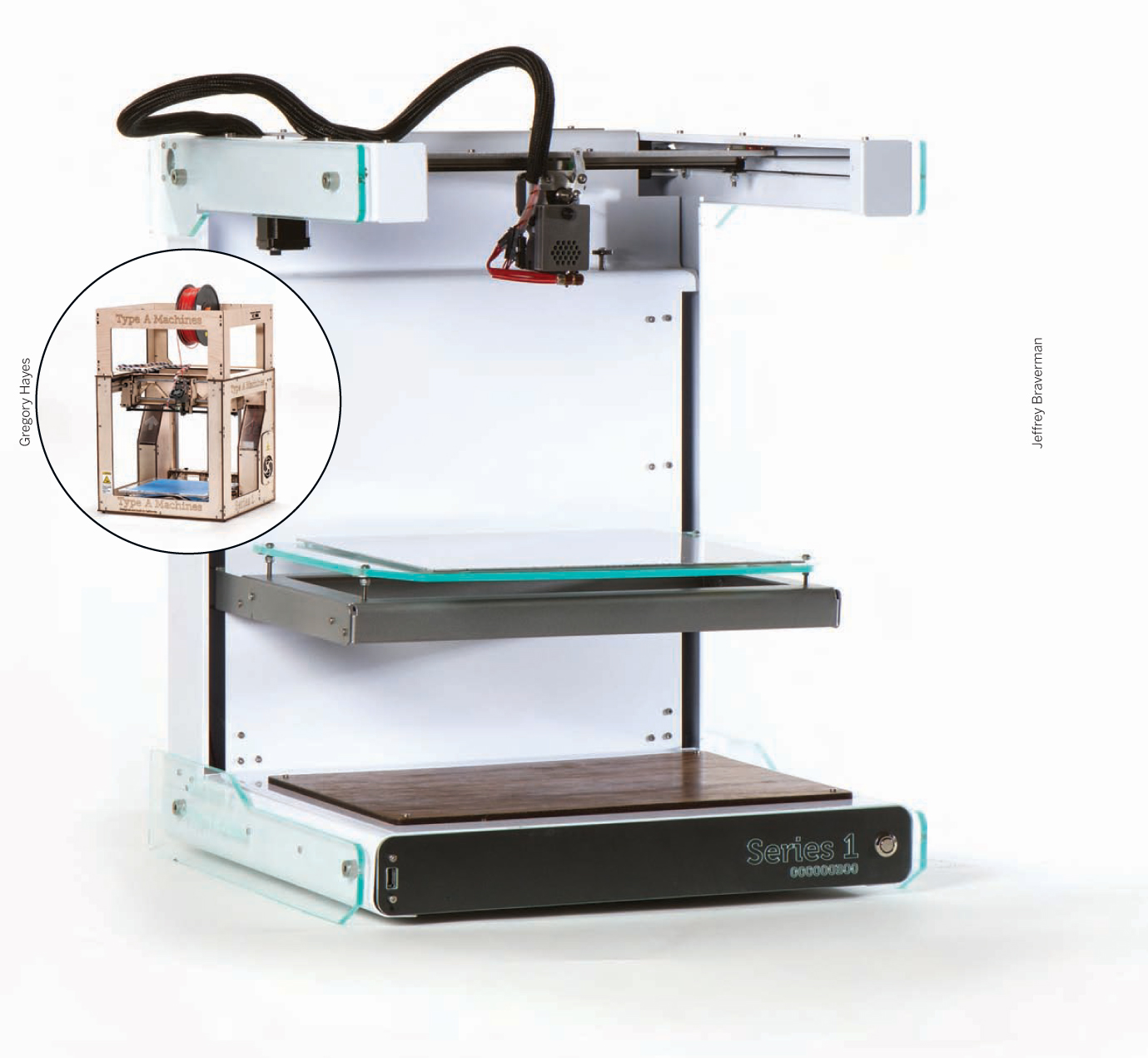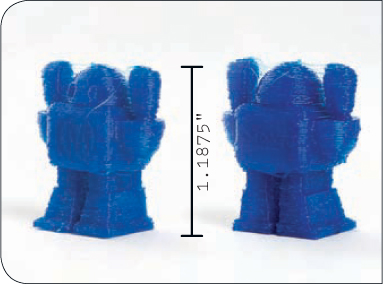TYPE A MACHINES SERIES 1
TYPE A MACHINES / TYPEAMACHINES.COM
With bold design and progressive wireless printing, it could be a 2014 frontrunner.
![]() Price as tested $2,295 (expected, 2014 model still in beta)
Price as tested $2,295 (expected, 2014 model still in beta)
![]() Print volume 12″×12″×12″
Print volume 12″×12″×12″
![]() Heated bed? No
Heated bed? No
![]() Print materials PLA, nylon, soft PLA, PET
Print materials PLA, nylon, soft PLA, PET
![]() OS supported Linux, Mac, Windows
OS supported Linux, Mac, Windows
![]() Print untethered? Yes, wi-fi and Octoprint
Print untethered? Yes, wi-fi and Octoprint
![]() Onboard control interface No
Onboard control interface No
![]() Open-source hardware? Some restrictions
Open-source hardware? Some restrictions
![]() Open-source software? Yes
Open-source software? Yes
![]() Printer control software Octoprint
Printer control software Octoprint
![]() Slicing software KISSlicer
Slicing software KISSlicer

Type A Machines was born out of the famous San Francisco hackerspace Noisebridge. Andrew Rutter started the company in December 2011 (see page 25) and launched the Series 1 printer the following spring. Type A describes its philosophy as “accessible source”: They will hold patents, but make all hardware specifications fully and publicly available for user modification (with commercial restrictions).
Most of our tests ran on Type A’s 2013 model Series 1. A new 2014 model is expected in October, and the 2013 model will no longer be available; we also tested a beta prototype of the 2014 machine, but had only a few hours with it. This review is split into two sections describing both models.
Out with the Old: 2013
The 2013 Series 1 ($1,695) is a significant upgrade from the 2012 model we rated “Best in Class” last year. It includes redesigned mechanics, an improved version of Type A’s Winchester extruder, a custom machined pinch-wheel, better motors, and a four-point build platform leveling system. The 2013 Series 1 also ships with a handy Top Hat spool-management system, so you can queue up a rainbow of spools and take advantage of the Winchester’s filament quick-change lever.
Our unit’s bed was out-of-level on delivery, so we releveled and recalibrated following the manual. We had little or no adhesion issues with this printer for the whole weekend, which was unusual among those we tested. The factory-supplied KISSlicer profiles worked well with very little adjustment. A slider controls the print speed, from Fast (90mm/s) to Precise (30mm/s). We found that pushing the speed past 65mm/s caused registration and surface-finish problems.
We used only one spool, so we didn’t test the Top Hat spindle for swapping. The spool occasionally unwound during homing, but it didn’t cause issues during printing. We tested using the bundled 1.75mm red PLA. After our configuration-sequence print, we went immediately for the Ultra Fine 50-micron layer height slicing profile and saw some problems with underextrusion, strings, and retraction. Type A support advised tweaking the slicing settings, lowering the speed and temperature, and measuring the filament’s real width using calipers. This advice was spot-on; our prints looked great afterwards, even on Ultra Fine.
In with the New: 2014
Compared to the 2013 model, the 2014 Series 1 ($2,295) boasts a clean industrial design, huge volume (the biggest in our tests), enhanced gantry mechanics, a glass build platform, and a new sheet-vinyl surface overlay that might just dethrone blue painter’s tape for printing PLA. A particularly interesting new feature, developed from user feedback, is an easy-to-remove, low-cost extruder nozzle cheap enough to be considered “disposable” if it clogs. Type A also promises a new “hacker-friendly” warranty that they’ll honor even if you’ve modified the machine.
Though the beta-stage prototype we tested did not have an onboard display (one was being considered for production), it did have another innovation — built-in wi-fi control via Octoprint, an open-source, web-based printer client that sends G-code and controls the printer via an embedded Linux platform. Installing Octoprint typically requires use of the Linux command line, but the Series 1 does it for you — it’s got a BeagleBone Black single-board computer with Octoprint preinstalled.
Our single test print showed minor PLA retraction issues that resulted in undesired stringing between free parts of the model, but we had only a few hours with a beta machine, so we can’t yet judge print quality. It’s worth reiterating that Type A’s 2012 and 2013 machines printed very well.
Conclusion
The Type A Machines 2014 Series 1 sets itself apart with the addition of integrated wireless printing, a sleek industrial design, and hacker-friendly warranty. It’s also slated to be compatible with direct printing from Windows 8.1. We look forward to this machine’s official release, anticipated in late October; check makezine.com/review for an updated review. ![]()
![]() Built-in wi-fi; Octoprint web-based printing
Built-in wi-fi; Octoprint web-based printing
![]() Biggest volume we tested
Biggest volume we tested
![]() Modular, swappable parts
Modular, swappable parts
![]() Hacker-friendly warranty
Hacker-friendly warranty
![]() “Disposable” extruders
“Disposable” extruders
Makers, Students, Architects, Makerspaces
![]() Use a spritz of hairspray for better material adhesion.
Use a spritz of hairspray for better material adhesion.
![]() Connect to your router via Ethernet cable if wireless printing gives problems.
Connect to your router via Ethernet cable if wireless printing gives problems.
![]() Clogged nozzle? Toss it and install a new one.
Clogged nozzle? Toss it and install a new one.
Type A Series 1 is the first printer to include an embedded Linux wi-fi board with Octoprint preinstalled, for open-source wireless printing right out of the box.

HOW’D IT PRINT?

